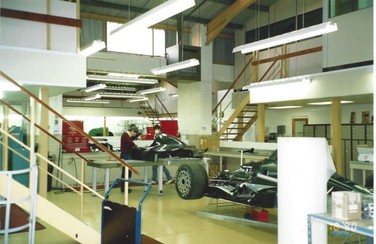Throwback Thursday - Penske Cars
April 7, 2016
One of the most-unique aspects of the 50 years of Team Penske is the history of Penske Cars, which was a division of Penske Racing from 1974-2006. In those 30-plus years, the factory in Poole, Dorset, England produced numerous INDYCAR winners and even a Formula 1 (F1) victor.
Roger Penske purchased the car-building shop from Graham McRae in 1973 and placed Heinz Hofer in charge of producing the first F1 chassis. Geoff Ferris was hired as engineer and designer of the new PC1 (Penske Cars, first iteration) chassis that would debut at the 1974 Canadian Grand Prix with driver, Mark Donohue.
Long-time Team Penske employee Karl Kainhofer arrived in the summer of 1974. Kainhofer was the chief mechanic on Roger Penske’s racecars in the 1950s and 60s, and would hold the same position for all of Donohue’s Can-Am and INDYCAR entries from 1966-1973. Kainhofer was tasked with assembling the car for the first race in Canada, one in which Donohue finished 12th. The team entered one more F1 race that season at Watkins Glen (N.Y.) International, but Donohue had to retire when his rear suspension broke.
For the next two years the Penske Cars chassis continued to compete in the F1 world. Irishman driver John Watson broke through for the team with a win in the 1976 Austrian Grand Prix just one year removed from the tragic accident that claimed the life of Donohue at the same venue.
Team Penske remains the last American team to win an F1 race.
Team Penske ceased to compete in F1 following the 1976 season and Penske Cars turned its focus to building a long line of ultra-successful INDYCAR chassis. Even though the INDYCAR operation was based in Reading, Pa., keeping the building of the chassis in England kept it closer to the shop than the California suppliers used by other organizations. The first INDYCAR was the PC-5, which appeared in the summer of 1977 with driver Tom Sneva. In the first race with the Penske-built machine, powered by a Cosworth engine, Sneva qualified on the pole at Michigan International Speedway before finishing in the fourth position.
In 1979, Rick Mears scored his the first of his record-tying four Indianapolis 500 wins in the PC-7. In total, Penske Cars chassis have won 82 INDYCAR races and seven Indianapolis 500 titles making it one of the most-successful chassis of the USAC-sanctioned era (1956-1995) of INDYCAR racing.
The most-dominant chassis in Penske Cars history was the PC-23 that Al Unser Jr, Emerson Fittipaldi and Paul Tracy used to dominate the 1994 INDYCAR season. That year the team won 12 of 16 races – including a historic performance at the Indianapolis 500 with the Mercedes-Benz engine – en route to a 1-2-3 finish in the series standings with Unser taking the crown.
The PC-29 chassis was the last to roll off the assembly line in Poole in 1999, marking an end to one of the greatest eras in INDYCAR racing as many of the teams – Team Penske included – moved from building their own chassis to the “spec” models we see today. The factory closed its doors in 2006.
While it no longer exists, the Penske Cars facility remains one of the proudest chapters of the Team Penske history book. Winning any major race is quite an accomplishment, but doing it with equipment that you build yourself makes it even sweeter.

